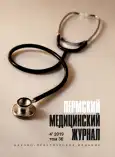Influence of congenital heart disease-caused hypoxia on intrathymic development of t-lymphocytes in children of first year of life
- Authors: Loginova N.P.1, Chetvertnykh V.A.1, Khromtsova G.A.1, Shekhmametyev R.M.2, Chetvertnykh L.A.1
-
Affiliations:
- E.A. Vagner Perm State Medical University
- Federal Center of Cardiovascular Surgery named after S.G. Sukhanov
- Issue: Vol 36, No 4 (2019)
- Pages: 46-54
- Section: Methods of diagnosis and technologies
- URL: https://journals.rcsi.science/PMJ/article/view/16488
- DOI: https://doi.org/10.17816/pmj36446-54
- ID: 16488
Cite item
Full Text
Abstract
Aim. To study the influence of hypoxia, caused by congenital heart disease, on the intrathymic development of T-lymphocytes and provision of the organism with T-cellular resource in children with cardiac pathology of different degree of severity.
Materials and methods. The paper presents the results of complex immunomorphological study of the thymus in children of the first year of life (n = 129) with congenital heart diseases. Hystochemical and immunological methods were used to assess the influence of congenital heart disease-caused hypoxia on the functional status of thymus regarding provision of a child with T-lymphocytes.
Results. It was established that the degree of severity of congenital heart disease correlated with the degree of suppression of T-lymphocyte pool formation. During the first year of life, proliferative activity of thymocytes (assessed by Ki-67 expression) in the thymus falls, being the reason of decrease in the number of CD3+ thymocytes. In conditions of marked hypoxia (blue type of defect) the process of T-lymphocyte differentiation is inhibited that causes preservation of less mature forms of thymocytes. As a result, hypoxia is the reason of proliferation suppression and thymocyte differentiation, influencing subpopulation composition of the cells. Thus, insufficient quantity of thymic migrants enters the peripheral blood that confirms low functional activity of thymus regarding provision of the organism with T-cellular resource.
Conclusions. No doubt, it can be the cause of immunodeficient state and reduced formation of adaptive immunity in this category of children.
Keywords
Full Text
##article.viewOnOriginalSite##About the authors
N. P. Loginova
E.A. Vagner Perm State Medical University
Author for correspondence.
Email: natalitsa@yandex.ru
доктор медицинских наук, доцент, профессор кафедры гистологии, эмбриологии и цитологии
Russian Federation, 26, Petropavlovskay street, Perm, 614000V. A. Chetvertnykh
E.A. Vagner Perm State Medical University
Email: natalitsa@yandex.ru
доктор медицинских наук, профессор, заведующий кафедрой гистологии, эмбриологии и цитологии
Russian Federation, 26, Petropavlovskay street, Perm, 614000G. A. Khromtsova
E.A. Vagner Perm State Medical University
Email: natalitsa@yandex.ru
кандидат медицинских наук, доцент кафедры гистологии, эмбриологии и цитологии
Russian Federation, 26, Petropavlovskay street, Perm, 614000R. M. Shekhmametyev
Federal Center of Cardiovascular Surgery named after S.G. Sukhanov
Email: natalitsa@yandex.ru
заведующий кардиохирургическим отделением №4 (детское)
Russian Federation, PermL. A. Chetvertnykh
E.A. Vagner Perm State Medical University
Email: natalitsa@yandex.ru
кандидат медицинских наук, доцент кафедры патологической физиологии
Russian Federation, 26, Petropavlovskay street, Perm, 614000References
- Белозеров Ю.М. Детская кардиология. М.: МЕДпресс-информ 2004; 9–221.
- Зиньковский М.Ф. Врожденные пороки сердца. Киев: Книга плюс 2009; 1169.
- Кондратьев В.А. Врожденные пороки сердца до и после операции. Таврический медико-биологический вестник 2005; 2: 76–82.
- Кнышов Г.В. Кардиохирургия в Украине: прошлое, настоящее, будущее. Сердце и сосуды 2003; 1: 8–14.
- Виноградов К.В. Врожденные пороки сердца у детей: распространенность и современное состояние проблемы. Здоровье ребенка 2007; 6: 9, available at: http://pediatric.mif-ua.com.
- Фроленко А.Л. Клинико-иммунологическая характеристика детей после тимэктомии: автореф. дис. … канд. мед. наук. Оренбург 2011; 26.
- Дударев И.В. Иммунологическая и гемодинамическая характеристика детей с врожденными пороками сердца синего и бледного типа. Иммунология 2002; 3: 167–170.
- Донецкова А.Д., Шарова Н.И., Никонова М.Ф, Митин А.Н., Литвина М.М., Комогорова В.В., Ярилин А.А. Вклад тимуса в восстановление популяции Т-клеток после действия различных повреждающих агентов. Иммунология 2013; 6: 309–313.
- Логинова Н.П., Четвертных В.А., Семченко В.В., Чемурзиева Н.В., Хромцова Г.А. Иммуноцитохимические особенности становления дифференцировки эпителиальных клеток тимуса у детей первого года жизни при эмбриональных нарушениях развития сердца. Фундаментальные исследования 2013; 12: 49–53.
- Turan T., Turan A., Arslan C., Kinoglu B., Sarioqlu T. How does neonatal thymectomy effect on the immune system. Acta cardiol 2004; 5: 511–513.
- Halton N.J., Jamieson B., Plunkett M., Kitchen C.M.R., Pham T., Krogstad P. Function and impaired maintenance of peripheral T cell populations in children with congenital heart disease and surgical thymectomy. Pediatric research 2005: 1: 2–48.
- Van Gent R., Schadenberg A.W.L., Otto S.A., Nievelstein R.A.J., Sieswerda G.T. Long-term restoration of the human T-cell compartment after thymectomy during infancy: a role for thymic regeneration? Blood 2011; 3: 627–634.
- Manchester K.L. Use of UV methods for measurement of protein and nucleic acid concentrations. Biotechniques 1996; 20 (6): 968–970.
- Livak K.J., Schmittgen T.D. Analysis of relative gene expression data using real-time quantitative PCR and the 2-∆∆Ct method. Methods 2001; 25: 402–408.
- Kong F.-K., Chen C.L., Cooper M. Thymic function can be accurately monitored by the level of recent T-cell emigrants in the circulation. Immunity 1998; 8: 97–104.
Supplementary files








